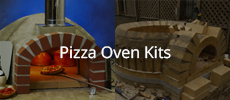This is my first oven build. I've been reading over FornoBravo plans, and talking with others on other forums. My plan is to use homebrew 3:1:1:1 (or AR fiber variation) to cast over a plastic mold, and use FB methods to build my outdoor oven. The main body of the oven will be casting only, however bricks will be used on arch. I just finished pouring the cement counter tops, and am gathering materials for the oven build.
Oven info:
Internal diameter will be 29"
Ceiling height: 20"
Door height: 13" (Should this be lower, say 11" ?)
Door width: 16"
The Premio 2G 100G oven has a 65% door to oven height ratio, and this oven would be the same.
Regarding the casting, what do you think about setting up the mold so that it has 3 separate dividers?
The advantages would be: Easy to move; oven joints would easily allow oven to expand and contract.
The mold is a Dogloo, but will be cut down by 6 inches to keep the height closer to spherical.
You have any suggestions on types of oven coatings that help keep it dry, besides a patio cover over it?
Oven info:
Internal diameter will be 29"
Ceiling height: 20"
Door height: 13" (Should this be lower, say 11" ?)
Door width: 16"
The Premio 2G 100G oven has a 65% door to oven height ratio, and this oven would be the same.
Regarding the casting, what do you think about setting up the mold so that it has 3 separate dividers?
The advantages would be: Easy to move; oven joints would easily allow oven to expand and contract.
The mold is a Dogloo, but will be cut down by 6 inches to keep the height closer to spherical.
You have any suggestions on types of oven coatings that help keep it dry, besides a patio cover over it?





Comment